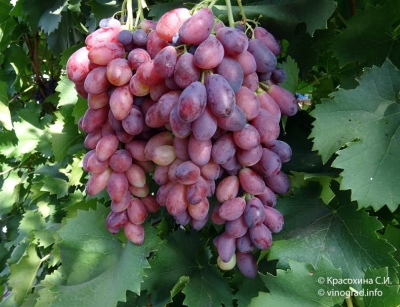
- Authors: Zagorulko V.V
- Appointment: dining room
- Berry color: red-purple
- Taste: harmonious
- With bones: Yes
- Ripening period: early middle
- Ripening period, days: 115-130
- Frost resistance, ° C: -21
- Flower type: functionally female
- Appeared when crossing: Demeter x Dunav
The Asya variety was bred in 2000. It is not considered the most popular table grape variety. The hybrid is distinguished by large berries and bulky bunches. Juicy and moderately sweet fruits are used by winemakers in the manufacture of blended wines, suitable for making juices and liqueurs. Picturesque climbing vines, high yield, good resistance to cold weather and fungal diseases are highly valued by gardeners.
Breeding history
Created by breeder Vitaly Zagorulko in the Zaporozhye region of Ukraine. Obtained by crossing the Bulgarian variety Dunav and the local complex-resistant variety Demetra. The new variety combines high taste and aesthetic qualities with unpretentiousness and high resistance to unfavorable climatic conditions.
Geography of distribution
It grows in Ukraine, Moldova, in the south of Russia: in the Krasnodar Territory, Stavropol Territory, in the North Caucasus, in the Crimea and areas on the Black Sea coast. Cultivation in the middle lane only with shelter for the winter.
Description
The variety is distinguished by a high decorative effect of shoots, leaves and fruits. Often planted to decorate houses, fences, gazebos, pergolas.
Ripening period
This is an early-medium hybrid in the ripening period. Vegetation - 115-130 days. The grapes ripen from late August or early September. Harvesting can be postponed a little - the fruits do not fall off, retain their attractiveness and do not deteriorate.
Bunches
They have an elongated cone-shaped shape, large ones - an average weight of about 700 g, but often reach 1 kg, 40-50 cm long. The density of the bunch is moderately loose.
Berries
The Asya variety has a purple berry color with a special reddish tint. The berries are egg-shaped, of impressive size, the weight of the grape can be up to 20 g, but usually 14-16 g. The dense and rather thick skin protects the fruits from damage. Therefore, the grapes rarely crack, there is a light waxy coating on the skin. The peel is not felt when chewed. The fleshy flesh is juicy and crunchy, usually with 2-3 seeds.
Taste
It does not differ in individuality, it is characterized as a typical grape. In warm sunny summers, the berries become sweeter and juicier. They have a lot of sugar - 18-20%, a small acid content - 4 g / l.
Yield
Differs in high productivity. With proper care, 12-18 kg of berries are harvested from one plant. Record from a bush - 25 kg.


Growing features
Landing
The vines are planted in rows with an interval of 2 m, from row to row the interval is 2.5 m. For cross-pollination, several grape bushes of a different variety with a bisexual type of flowering must grow nearby.

Pollination
The Asya variety carries only female inflorescences; for fruiting, the plant needs cross-pollination with a different variety. Flowers and ovaries do not crumble, not prone to peas.
Pruning
Pruning is carried out carefully, the variety has very fragile shoots. The grapes have a tendency to the appearance of many lateral shoots, in the spring they are cut into 6-8 eyes, leaving no more than 40 shoots on the bush. For the winter, shorten by 2/3. Excess growth is removed throughout the season.

Watering
The variety has drought tolerance, but excess moisture is contraindicated. Watering is necessary as the soil dries up; in the dry season, the frequency of watering is increased. After each irrigation, the soil is mulched. In autumn and spring, water-charging irrigation is done.
Top dressing
Fertilizers are applied during irrigation: in the spring - nitrogenous, in the summer - potash and phosphorus. It is recommended to alternate organic and mineral.


Frost resistance and the need for shelter
Asya grapes are distinguished by an average level of frost resistance, withstands up to -21 degrees Celsius. Planted in southern regions with mild winters. In severe winters and when cultivated in temperate climates, the vines are covered by laying on boards and covered with agrofibre.

Diseases and pests
It is resistant to diseases, but under certain conditions it is prone to defeat mildew, oidium, anthracnose, chlorosis. It is recommended to periodically spray with fungicides. In high humidity, it is prone to gray rot - it is necessary to remove the leaves around the bunches to provide fresh air. Ripening berries are fenced off with a net to protect them from birds, and gauze bags are put on the brushes from wasps.

If a grape is exposed to any disease or insect, this always affects its appearance.
Storage
Large brushes may crumble during transportation. To prevent this, the grapes are harvested only when fully ripe, and each bunch is packed in a soft container. Berries tolerate transportation well.
Review overview
Asya grapes are noted for high fruiting, fast-growing vines with spectacular foliage and berries. Not everyone likes the taste of the variety - slightly sweet, freshish. Very often grown for sale.











































































